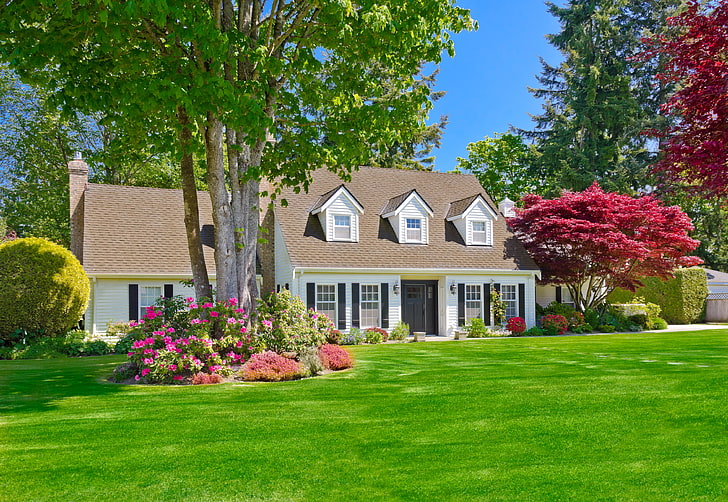
We typically consider our landscaping in terms of what is aesthetically pleasing and how much upkeep it requires. However, as we all become more aware of climate change and our own carbon footprints, landscaping is taking on a new purpose. Homeowners and businesses alike are looking to landscaping as a means of reducing energy consumption.
Thoughtful landscaping can lower your utility bills. And the good news is that you don’t have to do an entire overhaul all at once.
You can focus on one form of energy or one part of your yard at a time. Each change, no matter how small it may seem, is a step in protecting our environment and lowering energy costs. Here are just a few things you can do to lower heating and cooling, electricity, and water use through thoughtful landscaping.
Heating and Cooling
One of the most impactful ways of reducing energy consumption is by strategically planting trees and shrubs. Just three trees can reduce a home’s energy costs by more than $100 annually. For example, air conditioning units run 10% more efficiently when shaded by a tree. Shrubs, bushes, and vines planted near a home act as natural insulators, retaining warmth and reducing heating costs.
Creating windbreaks with trees and shrubs helps deflect winter winds while also providing shade, which has a cooling effect in the warmer months. If you live in an area that receives snow, low bushes and shrubs can stop winter winds from blowing snow up against your home, thus insulating your structure. There are different methods for effectively using trees depending on your local climate. However, all methods follow the same principles: block harsh winds and create shade.
Water Consumption
While choosing trees, shrubs, and other plants, you want to think about how they fit into the local environment. In our quest for beautiful homes and landscapes, we’ve often neglected to focus on native plants. Why native plants? Native plants create a beautiful space that requires less maintenance and uses less energy. We think of low-maintenance landscaping as a way of saving time, when in reality it is also a sustainable method of landscaping. Such gardening requires less water and fertilizer because the plants are well-suited to our local climate.
One of the biggest water consumers in most parts of the country is grass. Landscape irrigation accounts for about 50% of a home’s annual water use. To combat this, many people are forgoing traditional grass lawns and replacing them with native plants and xeriscaping. This is especially popular in drought-prone areas but is gaining popularity across the country. While you may not be ready to replace your entire lawn, consider starting with one area of your yard or a few flower beds.
For areas you’re not ready to convert, whether it’s grass, a flower garden, or a vegetable garden, there are other easy ways to reduce water use. Installing a drip irrigation system is an afternoon project that can reduce water waste by as much as 80%. In flower beds and around trees, a 2-inch layer of quality mulch can reduce watering by 30% due to reduced evaporation.
If watering with a hose or sprinkler system, only do so in the morning or evening to reduce the amount of water that evaporates before making it to the plant’s roots. It’s preferable to water in the morning, as cool temperatures in the evening can encourage water to sit around the roots and lead to fungal growth and insect infestations.
Electricity
Landscaping can also lower your utility bills. Most properties have several outdoor lights, including porch lights and security lights. An easy way to conserve energy is with solar-powered lighting. There are countless solar options on the market, including fixtures with built-in panels and ones with small wired panels that give you more flexibility. The panel must be positioned to receive ample sunlight during the day, so you’ll want to observe your space before making a purchase.
If you want lighting in a place that doesn’t receive a lot of sun during the day, go with lights that are motion activated. Such fixtures use very little energy while in standby mode: about a fifth of what is used when the light is shining. You also don’t have to worry about remembering to turn off the lights at bedtime or when the party ends. For lights you don’t use regularly, such as security flood lights, choosing a solar-powered, motion-activated fixture is the best way to conserve energy without compromising on functionality or safety.
Conclusion
Whether your motivation is to save money or save the environment –– or, probably, a little bit of both –– strategic landscaping is an easy way to reduce energy consumption. In fact, it takes just eight years of energy savings to recoup your investment in landscaping.
Landscaping can be expensive, but it’s not necessary to redo everything at once. Each season is an opportunity to invest in sustainability by choosing plants and products that support your goals of reducing energy use.
Written by Alison Hoover
About the Author
 Alison is a Midwesterner through and through and loves to spend her time traveling, baking, writing, and reading. Always at home in the dirt, as a kid, Alison raised a vegetable garden with her dad and flower gardens with her mom.
Alison is a Midwesterner through and through and loves to spend her time traveling, baking, writing, and reading. Always at home in the dirt, as a kid, Alison raised a vegetable garden with her dad and flower gardens with her mom.
You may also like
The Benefits of Sustainable Landscaping
10 Benefits of Composting For the Environment
How to Reduce Your Energy Consumption At Home
Sustainable Landscaping to Reduce Your Emissions
